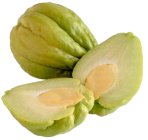Languages
Chayote

The chayote was used by the Aztecs long before the arrival of the Spanish conquerors. The chayote contains: 90% water, carbohydrates (starch), protein, potassium, calcium, iron, provitamin A and vitamin C (approx. 20mg%). The taste of the flesh is relatively neutral, somewhat sweetish, a mixture of cucumber and zucchini. Some say that chayote can treat hypertension. The chayote fruit is available all year round. Their weight is 200-450g. The fruit keeps well, it remains fresh for a long time and can easily be shipped.
Its origin are the mountains of Brazil, Central America and Mexico. Today, it is grown in plantations in Mexico, Guatemala, Honduras, Costa Rica, the Caribbean, California, North - and East India, in the coastal regions of Queensland/Australia, New Zealand, Hawaii, the Philippines, North -and West Africa and Southern France.
